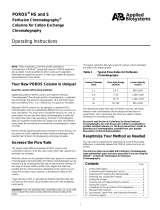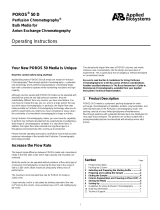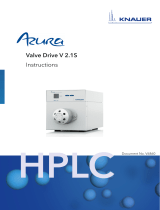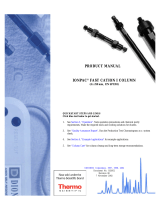Page is loading ...

ver.210628E
SHOWA DENKO K.K. (https://www.shodex.com/)
1
Operation Manual
Shodex
SUGAR
SC1011
(Please read this manual carefully to achieve the best and consistent column performance for a long time)
Important Handling Instructions
Caution! · Please consult the Safety Data Sheet (SDS) of reagents and solvents used with the column
and understand their proper handling methods to prevent potential health hazards or death
from occurring.
· Please wear appropriate personal protective equipment such as lab goggles and gloves
when handling organic solvents and acid and alkaline reagents. Avoid any direct physical
contact to prevent chemical injuries.
Before Using the Column
(1) Please visually inspect the package and outside of the column for any damage.
(2) Please check if product name and serial number written on the column package, column name tag, and
enclosed Certificate of Analysis (CoA) are matching and correct.
1. Introduction
Thank you for purchasing the Shodex product. Shodex SUGAR SC1011 is a high performance
chromatography column which is specifically designed for the separations and analysis of sugars. A strong acid
cation exchange type packing gel, prepared from a rigid resin of styrene divinylbenzene copolymer provides a
mixed separation mode. The analytes are separated by a combination of ligand exchange and size exclusion
chromatography modes. It is capable of separating and analyzing monosaccharides, disaccharides or
sugar alcohols from each other.
2. Column Components
3. Column Specifications
Product
Code Product Name
Column Size
(mm) Particle size
(μm)
Theoretical Plate
Number
(Per Column)
Exclusion Limit
*
I.D. Length
F6378102 SUGAR SC1011 8.0 300 6 ≥ 13,000 1,000
F6700090 SUGAR SC-G 6B 6.0
50 10 (Guard Column) -
*
Reference value only / Measured with pullulan
Base Material : Spherical porous particles of styrene divinylbenzene copolymer modified with sulfo group
(counter ion: Ca2+)
Column Housing : SUS-316
Screw Type : Internally-threaded type No.10-32 UNF
Shipping Solvent : Water

ver.210628E
SHOWA DENKO K.K. (https://www.shodex.com/)
2
4. Usable Conditions
* Increased temperature slows down the formation of sugar anomers, and thus prevents peak splitting.
Usable solvents are listed below.
(1) The standard eluent is water.
(2) Aqueous solutions of calcium nitrate or calcium sulfate salts can be used instead of water. Keep the pH of
solution between 3 and 7. For the analysis of samples containing large amount of heavy metals, addition of
10 - 50 µg/mL Ca-EDTA will prevent the deterioration of column performance.
(3) Up to 20 % (v/v) acetonitrile or ethanol is usable.
Attention! · Use the column within above stated flow rate, pressure, and temperature ranges. Using
the column outside the given range may damage the column and lower its performance.
· Do not use salts other than calcium salts. Use of other salts may replace the calcium ion
attached to the sulfo functional group with other cation and may deteriorate the column.
· When using a mixture of salt solution and organic solvent, make sure there is no
precipitation of salt.
· Column pressure is influenced by the eluent composition, flow rate, and column
temperature. When changing the eluent compositions, adjust the flow rate and column
temperature so that the column pressure remains below the usable maximum pressure.
5. Eluent Preparation
(1) Degas the eluent fully to prevent the formation of air bubbles.
(2) Presence of small debris or insoluble substances may result in deterioration of the column and/or they appear
as noise on the chromatograms. Filter the eluent with a 0.45-μm disposable filter to prevent the problems.
Attention! · Whenever water is required, use ultra-pure water freshly generated by a water purification
system or water from a newly opened HPLC grade distilled water bottle. Use HPLC grade
organic solvent whenever possible. Solvents left in an opened bottle for a long time should
not be used. The content may have been changed, absorbed moisture, or has been
contaminated.
· Always use freshly prepared solvents. Solvents stored for a long time may have changed
their compositions and may influence elution patterns and/or damage the column.
Note · Use of on-line degasser is recommended.
6. Sample Preparation
(1) If possible, use the eluent for analysis to dissolve or dilute samples. If this is difficult, use a solvent which
has a composition that is as close as possible to the eluent's composition, but which fully dissolves or dilutes
the sample. When gradient elution is used, it is recommended to use the initial eluent to prepare the sample.
(2) Filter the sample solution using disposable 0.45-μm filter to prevent the column from clogging or deteriorating.
(3) Recommended sample injection volume is less than 20 μL per column.
(4) When analyzing an acidic or a basic sample, make sure to neutralize the sample prior to the injection.
(5) When a sample contains cations other than calcium ions (the pretreated sample after neutralization), remove
them by using a cation exchange resin.
(6) When a sample contains protein or lipid, make sure to remove them prior to the injection. Proteins may be
removed by ultrafiltration or by adding acid or acetonitrile. If using acid to remove the protein, neutralize the
sample before injection. If using acetonitrile, make sure that the final acetonitrile concentration is less than
20 % (v/v).
(7) When a sample contains a large amount of organic acids, use an OH-form anion exchange resin to remove
them.
Product Name Flow Rate (mL/min) Maximum Pressure
(MPa) (Per Column)
Temperature (°C)
Recommended Maximum Recommended* Maximum
SUGAR SC1011 0.5 - 1.0 1.5 4.0 70 - 85 95
SUGAR SC-G 6B - -

ver.210628E
SHOWA DENKO K.K. (https://www.shodex.com/)
3
(8)
When a sample contains hydrophobic substances or surfactants, use a reversed-phase solid phase
extraction to remove them.
Note
· Use of guard column is recommended to protect the analytical column.
7. Column Usage Procedure
7.1 HPLC System Preparation
Wash entire LC system prior to the column installation, including all flow-lines and sample loop by switching the
valve, and then replace the washing solution with the eluent to be used. If desired new eluent has low
miscibility/solubility to the eluent of previous analysis, first use the eluent that is miscible/soluble to both eluents,
and then replace it with the desired eluent.
e.g. When replacing chloroform to water, first run methanol and then introduce water.
Attention! · If the eluent left in the system is not compatible with the column to be used, it may damage
the column.
· A drastic change in the eluent compositions may remove substances adsorbed on the
system and they may enter and deteriorate the column.
7.2 Column Installation
(1) Connect the column to LC system by following the “flow direction arrow” (➡) indicated on the column name
tag. If guard column is used, position the guard column in front (before the inlet) of the analytical column.
(2) Make sure to insert the tubing all the way to the end fitting and secure it with the male nut. It is important that
there is no extra space between the tubing and the column side of the end fitting. Presence of an extra space
will let the sample to spread out and may result in wide peaks.
(3)
Set the initial flow rate at 0.2 - 0.3 mL/min and start the system. If using the column at an elevated
temperature, keep a low flow rate until the temperature of the column reaches to the set temperature, and
then gradually increase the flow rate to the desired.
(4) At the end of analysis, reduce the flow rate to 0.2 - 0.3 mL/min and turn the column oven off. Make sure that
the column oven temperature is at room temperature before turning off the pump.
Caution! · Verify that there is no solvent leak. It may cause electronic leakage, rust, and/or chemical
injury.
Attention! ·
Make sure not to let air bubbles enter the column while installing the column. The air
bubbles may damage the column.
· When restarting the system after column installation or after holding the eluent flow, start
the system at 0.2 - 0.3 mL/min. A rapid increase in pressure can damage the column.
· If the column was used at an elevated temperature, let the column temperature return to
room temperature before stopping the pump. If the pump was stopped while the eluent
inside the column was still hot, as the eluent temperature decreases, its volume also
decreases. This may result in creating an empty space in the column and deteriorates the
column.
Note
· It is recommended to set the pump limiter to avoid exceeding the maximum pressure.

ver.210628E
SHOWA DENKO K.K. (https://www.shodex.com/)
4
7.3 Solvent Exchange
When replacing the solvent, set the column temperature at 50 °C and start the system at 0.2 - 0.3 mL/min.
Recommended solvent volume to introduce at each step is 3 to 5 times of the column volume.
Attention! · Frequent eluent replacement may damage the column, and thus not recommended.
7.4 Column Cleaning (Regeneration)
Problems in peak shapes and elution time changes or elevated column pressure etc. are often caused by
insoluble or adsorbing components present in the eluent and reagents being deposited inside the column. These
problems may be resolved by cleaning and/or regenerating the column.
If a guard column is used with the analytical column, first remove the guard column and check the performance
of the analytical column alone. If the problem is solved, most likely the cause is from the guard column. In this
case, clean and/or regenerate the guard column.
If the problem is not solved by removing the guard column, clean and/or regenerate both guard and analytical
columns. Make sure to clean and/or regenerate the guard and the analytical columns separately. When washing
and/or regenerate the column, let the washing solution flow from the column outlet go directly into the waste
container and not let the solution go through the detector.
<Cleaning Method>
Insoluble components that block the column inlet may be removed by reversing the flow direction, i.e.,
introducing the eluent from the column outlet, with flow rate at less than half of the recommended flow rate.
<Regeneration Method>
Presence of cations other than calcium ion in the sample may replace the calcium ion attached to the sulfo
functional group. This can change the separation patterns and peak shapes. Following regeneration procedure
reattaches the calcium ions and may resume the column performance.
Set the column temperature at 50 °C and the flow rate at 0.5 mL/min. Introduce 50 mL of 0.1-M aqueous calcium
nitrate solution.
8. Column Storage
Remove the column from the system after replacing the in-column solvent with the shipping solvent. Securely
tighten the end caps and store the column at a location with stable temperature (a cool and dark space is
recommended). Refer to section 7.3 Solvent Exchange for how to replace the eluent.
Attention! · Never allow inside of the column to dry. It can damage the column.

ver.210628E
SHOWA DENKO K.K. (https://www.shodex.com/)
5
9. Column Inspection
Inspection method is described in the Certificate of Analysis (CoA).
Theoretical Plate Number (N) and Asymmetry Factor (Fas) were calculated using the below equations.
(1) Theoretical Plate Number (N)
(2) Asymmetry Factor (Fas)
10. Additional Warnings
(1) Do not remove end fittings.
(2) Do not make a strong impact on the column. Do not drop or hit the column on a hard surface.
Refer to the Shodex™ website (https://www.shodex.com/) for product details and their applications.
For additional assistance, contact the distributor from whom you purchased the column or contact your regional
Shodex support office (https://www.shodex.com/en/support_office/list/).

ver.210628E
SHOWA DENKO K.K. (https://www.shodex.com/)
6
11. Warranty (Ver. 4COLUMN)
(1) Showa Denko K. K. warrants that the Shodex product, at the time of delivery to the user, will conform to
the specification of the attached CERTIFICATE OF ANALYSIS, if the Shodex product is used in accordance
with the attached operating manual. The foregoing warranty is exclusive and is in lieu of all other warranties
with respect to the Shodex product, whether written, oral, implied, statutory or otherwise. No warranties by
Showa Denko K. K. are implied or otherwise created, including, but not limited to, the warranty of merchantability
and fitness for particular purposes.
(2) Any claim of inconformity to the specification must be notified to Showa Denko K.K. within ten (10) days after
delivery to the user. User’s exclusive remedy and Showa Denko K.K.‘s exclusive liability for such claim are
limited to the replacement of the Shodex product in question. In no event is Showa Denko K.K. liable for any
indirect, incidental or consequential damage arising out of in connection with the Shodex product, whether or
not such damage is allegedly based on breach of warranty, negligence or otherwise.
(3) No warranty is made in any of the following cases:
3-1 If the Shodex product is not used in accordance with the operating manual
3-2 If the Shodex product is remodeled by anyone other than person or firm designated by Showa Denko K.K.
3-3 If the Shodex product is disposed of
3-4 If the Shodex product is resold by the user without giving prior written notice to Showa Denko K.K.
3-5 If the performance of the Shodex product is not conform to the specification of the attached CERTIFICATE
OF ANALYSIS due to any of the reasons below:
a. Computer virus
b. Impurities contained in the sample, reagent, gas air or cooling water provided by the user
c. Breakdown or malfunction of equipment, apparatus or component used in combination with the Shodex
product
d. Force majeure such as fire, earthquake, flood, other natural disaster, crime, riot, act of terrorism, war or
radioactive contamination
(4) In no event is Showa Denko K.K. liable for
4-1 the results of analysis or preparations using the Shodex product or any portion of the same, including, but
not limited to, the reliability, accuracy, efficacy and safety of said results, and
4-2 the occupational hazard in the use of the Shodex product, whether or not such use is made in accordance
with the attached Conditions for use.
(5) The Shodex product is for laboratory use only. It must not be used for clinical diagnosis. Showa Denko K.K.
is not liable for any use of the Shodex product except laboratory use.
Following names are trademarks or registered trademarks of SHOWA DENKO K.K.
Shodex, AFpak, Asahipak, AXpak, CLNpak, CXpak, HILICpak, MSpak, ODP, OHpak,
ORpak, RSpak, SUGAR, USPpak.
Products described in the operation manual are not intended for medical use or medical applications.
/





